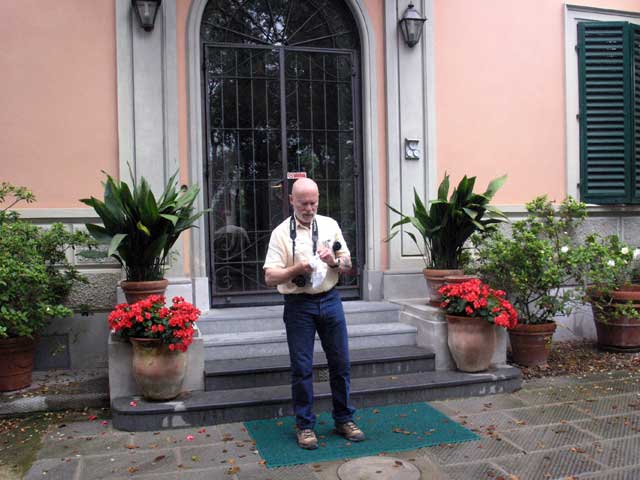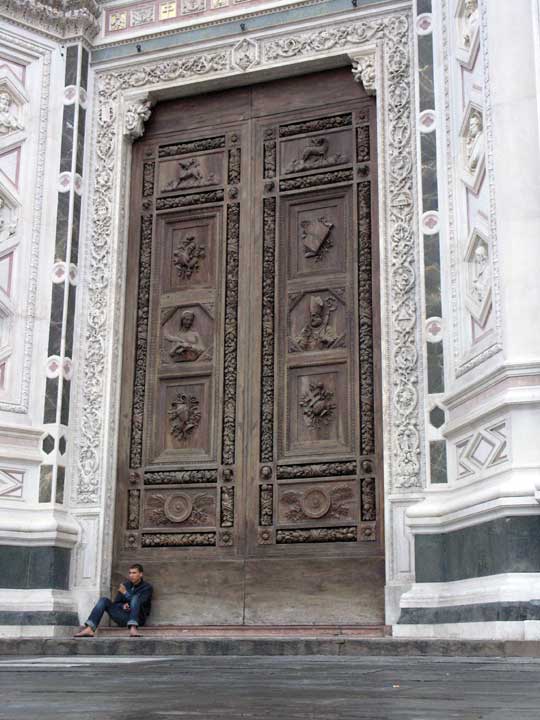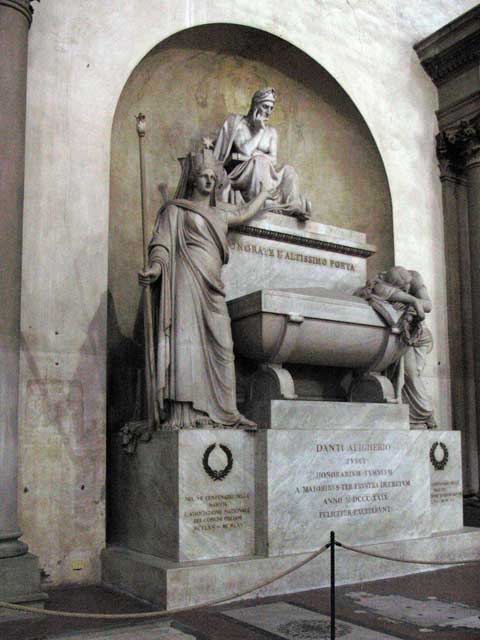
Heading out the door in the morning.

The next morning we headed off to do laundry after breakfast and have been sitting here watching our laundry go around in circles – now with about 1 minute left to dry.
After swinging through an internet café and depositing the laundry in our hotel room, we checked with the desk to see if we could get reservation to the Galleria dell’Accademia – the museum where Michelangelo’s David is displayed. We were fortunate to get a 1530 appointment for the same day. When we walked by the museum in the past day or so, the line for the “unreserved entry” was long and never seemed to move.
In the meantime, we went to the Basilica di Santa Croce on Erika’s recommendation. The weather continued with intermittent showers so we periodically had our umbrellas up as we made our way there. The basilica is a huge space where the forward part of the church around the altar was completely obscured by scaffolding for restoration work. One of the reasons we went was to see the tombs of Galileo and Michelangelo, which were facing each other across the nave – as Galileo was born the same year Michelangelo died. (And Newton was born the same year Galileo died.) From there we backtracked a couple blocks to a restaurant I spotted for lunch. We sat outside under the umbrella as the rain got heavier while we sipped wine (me) and beer (Jonathan).

Well, they have a place for Dante, but after exiling him, they can't seem to get the body back from Ravenna.
Finishing lunch, we wandered off to the Basilica di San Lorenzo, which was the Medici’s home church. As I mentioned earlier the exterior is brick and mortar, while the inside is (of course) completely finished. My impression (unfortunately, photography was prohibited) was that the décor of this church was much more elegant and less cluttered compared to most of the comparable churches we’d seen. Some of those churches are crammed full of ornamentation in every available space, while San Lorenzo hadn’t lost it’s architectural style beneath a blizzard of art pieces.
We had to exit the basilica and circle around to the backside of the structure to enter the Chapel of the Medicis. This was a large circular space with alcoves on four sides with huge sarcophagi in each alcove – except the altar – where the various Medicis were laid to rest. This chapel was a riot of multi-colored marble and other stone that borders on the tacky. Clearly the Medicis had a lot of money – and perhaps the style was tasteful then, although I suspect it screamed of conspicuous consumption even then.
Off this chapel was a smaller chapel that I remembered from my previous trip to Florence 35 years ago. This chapel was designed by Michelangelo and has the famous figures of Day and Night, Dawn and Dusk gracing the sarcophagi. Unfortunately these chapels also forbade photography so the only pictures I have date from 1973.
We wandered around a bit to spend some time before our 1530 appointment at the Galleria dell'Accademia. Once there we joined the relatively short queue for reservations holders and entered the museum. We paid an extra 4 euros each for the reservation, but it was money well spent to avoid waiting in line. Once in the museum (no photography here either), we wandered among the paintings, then into the side gallery where the “Prisoners in Stone” are located. I find the unfinished nature of the sculptures attractive in that they are not overworked, not over polished, and leaves a lot of room to engage the viewer’s imagination.
At the end of the gallery, the David is the center of attention with the crowd swirling around the base to get a full 360 degree view of the work. The David is, of course, polished and finely worked. It once stood outside the city hall in Palazzo Vecchio where a replica now stands. On our way out, I bought a couple of postcards of the “Prisoners” to scan for the web page.
We returned to the hotel where we took a nap before dinner. We went back to the Piazza Sancto Spirito to find a restaurant – Osteria Sancto Spirito – where we sat outside. I had an appetizer of fried proscuitto wrapped around mozzarella with greens, risotto with zucchini and cheese, and duck with balsamic reduction. We finished with espresso and a cordial – Jonathan had a grappa while I had limoncello.